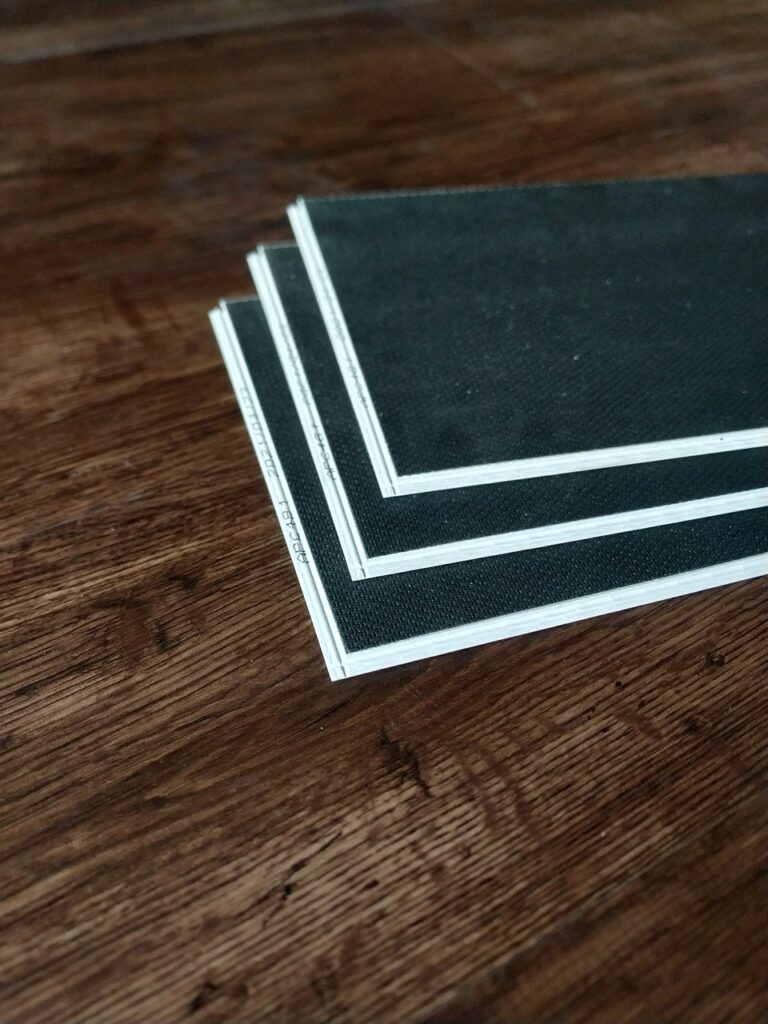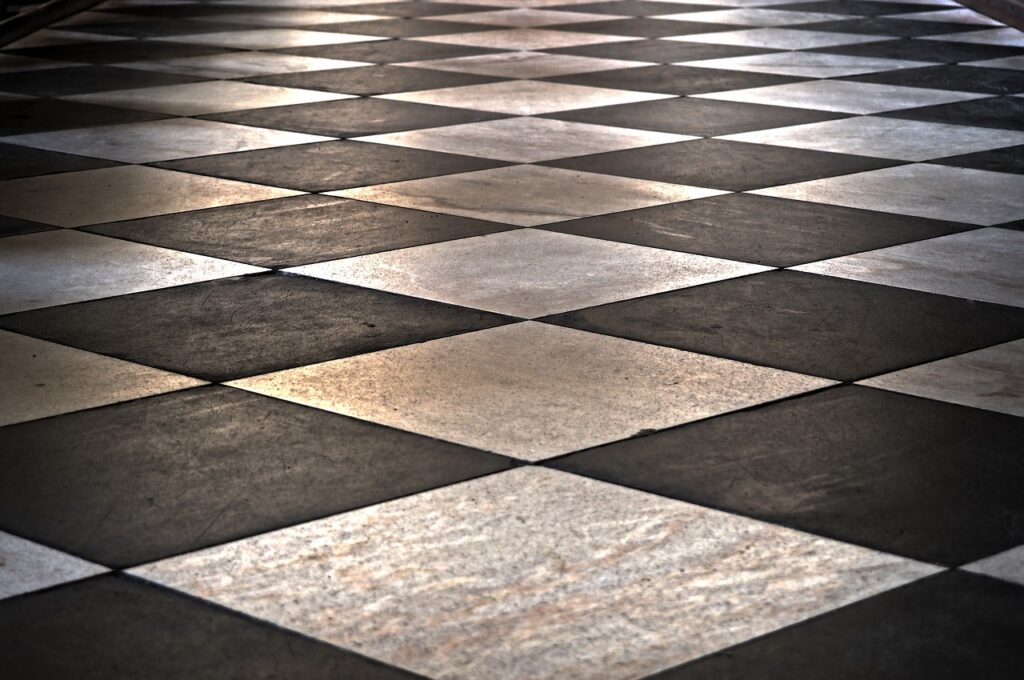I got many inquiries about the composition of vinyl flooring and requests for more detailed information when I wrote on Fb not to use vinyl flooring in the bedroom and in the child’s room
It is important that when installing vinyl floors at home, we install a material in our space that each day gives off substances that affect health, especially the endocrine system of children and pregnant women.
These substances become a component of the air we breathe. These compounds are in high concentration right next to the floor, they can be worn by children on their hands, they can be absorbed through the skin or from hands and toys to the digestive system.

VINYL FLOORING – COMPOSITION, TYPES, SAFETY LEVEL – PVC
We know vinyl floors in the form of floor panels, tiles, rolled out. Advertisements describe them as colorful, easy to arrange, pleasant to the touch, calming and above all cheap. Their main component is polyvinyl chloride (PVC). And it is precisely this (that vinyl consists of vinyl) that can negatively affect health, especially of children and pregnant women.
Polyvinyl chloride (vinyl) is one of the most harmful materials in our environment, a mixture of many toxic compounds, including chlorine (chlorine is essential for the production of PVC). 60 harmful chemicals have been identified in the air above PVC flooring, some of which are easily absorbed through the skin.
Pure PVC is hard and brittle. It needs softeners. The most commonly used plasticizers are phthalates. Recent studies have found that phthalates are endocrine disruptors that can interfere with development, reproductive health, metabolism, mood, and the nervous system. Pigments (lead and cadmium compounds), antistatic compounds, modifiers, optical brighteners, stabilizers are also added. As these additives are flammable, anti-inflammatory retardants are required. These increase the production of smoke – so anti-smoke agents are needed. Such a large number of admixtures attracts bacteria and… makes it necessary to add biocides. Most of these compounds as well as remnants of carcinogenic vinyl chloride tend to be released from the plastic. Many of them cause cancer, allergies, and genetic and hormonal changes.
Therefore, a few years ago, bottles with vegetable oils began to be made of PET, instead of PVC, although PVC water pipes are still being installed.

“LUXURY VINYL FLOORS” / LUXURY VINYL FLOORS (LVF) – WHAT REALLY IS?
Even though a vinyl tile is advertised as containing plastic composite (WPC), it is still not made of real wood. It only has sawdust which is associated with a lot of plastic. Luxury vinyl tile is mainly composed of polyvinyl chloride (PVC).
Even though a vinyl tile is called “Walnut Vinyl Flooring” and looks like wood on the surface, it is not wood. While laminate is made of engineered wood, luxury vinyl tiles (LVT) and luxury vinyl plank (LVP) are still made of PVC. In turn this PVC is made of ethylene and chlorine. Ethylene comes from petroleum fuel sources (such as crude oil) and chlorine comes from salt.
So don’t be fooled by the surface of the printed film with a surface that looks like wood. Producers use carefully formulated phrases such as “environmentally friendly”, “inspired by nature”, they use the names of specific species of wood. Don’t be fooled – it’s still mostly PVC.
VINYL FLOORING – METHOD OF TESTING AND APPROVING PRODUCTS FOR SALE
Tests allowing a given product for use are carried out in laboratory conditions, at a maximum temperature of 23 degrees. At such a temperature, the panels spontaneously emit relatively little VOC (Volatile Organic Compounds). The higher temperature that we often have at home in summer significantly increases the amount of volatile substances in the air.
Even if the manufacturer declares that his vinyl flooring does not contain formaldehyde it should be read with understanding. Formaldehyde is more common in laminate flooring where it is found in glue and resin. The levels in vinyl flooring are usually lower than in laminate flooring. It should be remembered that the components of the adhesive with which the vinyl flooring is attached to the substrate are also important.
While many types of phthalates are prohibited for use in children’s toys, no current legislation prohibits or restricts their use in vinyl flooring products.
In the event of a fire, PVC releases hydrogen chloride (HCl) as well as dioxins and furans (PCDD and PCDF) – the most harmful substances known to toxicology even at a temperature of 120 Celsius degrees . 2,3,7,8-tetrachlorodibenzodioxin is 10,000 times more toxic than potassium cyanide.
Polish building regulations prohibit the use of highly smoky and poisonous products during a fire in finishing buildings. The approvals that the manufacturers refer to only state that they are non-flammable, and do not say anything about the emission of poisonous gases.
Manufacturers refer to various institutions approving products for use, tests and approvals. For example the Californian FloorScore program checks the amount of volatile compounds in the air (above the carpet) but does not check the amount of phthalates. At the same time it is good to know that the manufacturer is responsible for the research. Another program, the Greenguard Gold Level for schools and children also tests phthalates and is currently considered the most stringent VOC emission test.

VINYL FLOORING AND THE ENVIRONMENT
PVC products are not biodegradable and not recyclable. In a landfill the entire toxic composition of PVC is released into the environment over time. Burning is an even worse solution. Burning 1 kg of PVC emits 50 micrograms of dioxins – one of the most dangerous chemicals in our environment. We have an impact on the environment when deciding to buy a vinyl or other floor.
The use of PVC is prohibited in most municipalities in Germany, Netherlands, Sweden, Luxembourg, and 6 states of Austria (including Vienna).
Since the 70’s Greenpeace has been campaigning to stop the production of chlorine compounds.

WHAT INSTEAD?
A wide variety of goods are made of PVC: carpets, wallpapers, cable insulation, windows, pipes, gutters, clothes, and everyday items. We can replace all these products with healthier and more durable counterparts.
Replacements for vinyl floor coverings are:
- natural linoleum (one based on linseed oil, not to be confused with artificial)
- marmoleum (variety of linoleum)
- hardwood
- ceramic tiles (stoneware)
- cork
Note on recycled PVC
Avoid buying recycled floor coverings, especially post-consumer PVC materials. They are mixtures of materials made according to old norms and standards, which may have higher levels of formaldehyde, arsenic, phthalates and even stabilizers such as lead.
We spend 90% of our time in inner space every day. We, healthy adults, are better at removing harmful substances from the body, but the elderly, people in treatment, young children, including newborn especially, need smart choices and good support!
WHAT TO DO IF WE ALREADY HAVE VINYL FLOORING?
Ventilate the room frequently.
If possible control the temperature in the room and prevent it from increasing above 23 degrees.
Place a carpet made of natural materials (cotton, wool, jute and similar) on the PVC floor.
Remove dust indoors.
Use an air cleaner (device with HEPA filter).
Carefully choose the rest of the room furnishings to avoid adding VOCs from other sources.
We have no influence over the materials in schools, kindergartens, offices, but we have influence and control over our own home.

